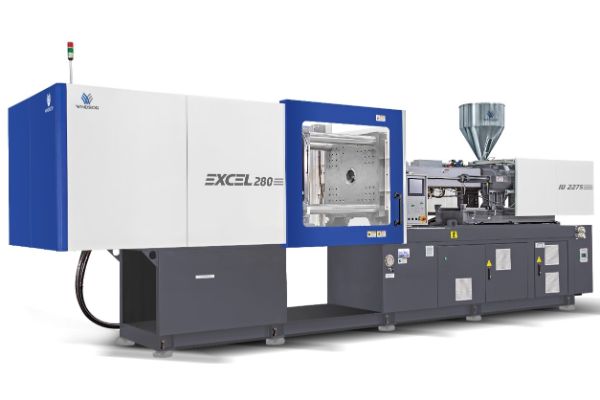Towards the Grand Design

An interesting account of how Windsor Machines could achieve enhancement in electrical drawing quality, reduction in errors and increase in productivity through EPLAN engineering design software.....
Windsor Machines Ltd is a global plastic processing machinery manufacturer with its manufacturing facilities in India and Italy. The company owes its reputation to more than five decades of continuous improvement. From Injection Moulding Machines and Pipe Extrusion Lines to Blown Film Lines, the range of products it has developed straddle every conceivable use case.
The convergence of technological prowess with innovation has helped create machines with capacities from 350 to 2000 tonne that are at work in diverse sectors. Benchmark defining products and multiple patents add to the expanding portfolio of solutions that emerge from the advanced development centers. Some of the products include Integrated PET Preform system, ram type hydraulic machines, toggle machines, KL series two-platen machines, and patented jaw clamping system among others.
Bringing complex concepts to life
Prior to deploying EPLAN software, conceptualization was laborious and prone to errors. By virtue of the extensive range of products, standardization and voluminous data sets were routine challenges that beset the product development process. Integrating and configuring value engineering requirements was an uphill process, having to contend with the lack of standardization. Process optimization was hampered by delays attributed to manual data sets that slowed down engineering workflows.
The need to extend the value proposition was felt in a market that was upended by digitalization. Troubleshooting, integration of components in an easy to retrieve library, storage of scalable schematics, and tagging were areas that needed to be addressed on priority. Automation works best only when implemented enterprise-wide and this was one area that needed to move to the next level for creating an overarching and seamless product development workflow.
Transition to EPLAN electrical drawing solution
The advantages of EPLAN over traditional CAD solutions include the ability to automatically connect, restore or break lines, tag devices, carry out numbering of wires, and the automated generation of reports/BOMs. The integration/compiling of a massive library in the EPLAN Data Portal offers instantaneous access to a huge repository of components that are integral to standard products. The advanced functionalities on the portal enable the storage of a large number of scalable schematics, in addition to the ease with which various formats such as PDF, DWG, and XML files can be generated through simple conversion options. Querying for components and parts are on the next level with aided/intelligent parts selection and management.
The host of features include support for pre-schematic engineering, and simplified cross reference identification in electrical circuits. This feature is presently unavailable in commercially available electrical CAD software, highlighting the futuristic and advanced nature of the solution. The solution also triggers error messages on time, helping teams to fix errors during various stages. The finer aspects of development, including calculation of cable length, mounting plate detail with cut-out and holes, are handled automatically, slashing the time required in processes.
Induction, training and support


The migration to EPLAN was worked out to the last detail, overcoming all adoption challenges. A comprehensive training session addressed the gap in skill sets and demonstrated the various methodologies for efficient generation of data. Standardization, procedures and technical details in processes were explained to the team. The shift from old CAD platform to EPLAN also involved the matching of specific requirements of Windsor Machines with various modules in EPLAN for desired outcomes. Configuration, creation of sample electrical circuits, tool demonstration, and generation of reports were showcased to participants.
On conclusion of in-depth training, a dedicated team handled all queries of team members. The interactive, self-service portal addressed most issues while the dedicated team handled other adoption challenges.
Standout benefits from EPLAN adoption
Among the numerous benefits from the migration to EPLAN, standout benefits include features that have transformed various processes. Automatic report generation, BOMs, access to library of components, storage of schematics, conversion to various formats, ease of troubleshooting and cross reference identification in electrical circuits have engendered process optimization at Windsor Machines. The reduction in time taken for preparing circuits combined with the elimination of errors has helped Windsor Machines to boost productivity and enhance quality. The simplification of processes has reduced complexities and manual intervention, helping Windsor Machines to bring innovative concepts to life in the shortest possible time.
Challenge
- Conceptualization was laborious and prone to errors. By virtue of the Windsor Machines’ extensive range of products, standardization and voluminous data sets were routine challenges that beset the product development process.
Solution
- EPLAN’s standout benefits include features that have transformed various processes. Automatic report generation, BOMs, access to library of components, storage of schematics, conversion to various formats, ease of troubleshooting and cross reference identification in electrical circuits have engendered process optimization at Windsor Machines. The reduction in time taken for preparing circuits combined with the elimination of errors has helped boost productivity and enhance quality.
Benefits by the Numbers
- Productivity has increased by almost 200%.
- number of electrical drawings has leapt from 18 to 35 per month.
- total elimination of errors.
- has undergone a transformation – errors have been slashed
from 24 per month to 1 every month.
The migration to EPLAN was worked out to the last detail, overcoming all adoption challenges. A comprehensive training session addressed the gap in skill sets and demonstrated the various methodologies for efficient generation of data.



 Facebook
Facebook.png) Twitter
Twitter Linkedin
Linkedin Subscribe
Subscribe